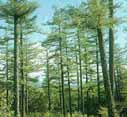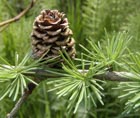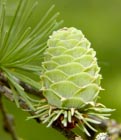Larix kaempferi
(Lambert) Carriére 1856
Common names
カラマツ Karamatsu [Japanese], Japanese larch (Farjon 1990).
Taxonomic notes
Synonymy (Farjon 1998):
- Pinus kaempferi Lambert 1824
- Larix kaempferi (Lambert) Carriére var. rubescens Inokuma
- Larix kaempferi (Lambert) Carriére f. rubescens (Inokuma) T. Shimizu 1983
- Pinus larix Thunb. 1784 non Linnaeus 1753
- Abies leptolepis Siebold et Zuccarini 1842
- Pinus leptolepis (Siebold et Zuccarini) Endlicher 1847
- Larix leptolepis (Siebold et Zuccarini) Gordon 1858
- Larix japonica hort. ex Carriére 1855
- Larix japonica A. Murray bis 1863 non Carriére 1855
- Larix leptolepis var. louchanensis Y. de Ferré et M.T. Augère 1943
The hybrid of L. decidua and L. kaempferi is Larix × marschlinsii. This hybrid, which arises when the trees are planted near each other, almost alway shows L. decidua as the pollen donor and L. kaempferi as the seed parent. The hybrids show high heterosis (hybrid vigor) (Eckenwalder 2009).
Description
Monoecious. Tree up to 40 m tall and 150 cm dbh, may be much smaller at high elevations. Trunk round, straight, with long, horizontally spreading first order branches, and short, slender, drooping second order branches. Crown is conical, dense, becoming irregular and more open with age (or on exposed sites). Bark smooth and red-brown on young trees, becoming first scaly and later fissured, dark brown weathering to gray. Branchlets are of two kinds, as in all Larix species. The long shoots are slender, flexible but not drooping, pale yellowish brown, smooth between prominent grooves, glabrous or slightly pubescent, with weakly developed pulvini at the ends of the ridges. The short shoots (2-7 mm long, ca. 4 mm across) have traces of scales crowded into one to seven rings. The terminal vegetative buds are conical, 4-5 mm across, while the lateral buds are subglobose and 3 mm across. Both are slightly resinous with dark red-brown triangular-ovate bud scales having erose margins. Leaves are deciduous, grey- or blue-green, turning bright yellow in autumn. They are spirally arranged on long shoots, to 6 cm long and 2 mm wide. On short shoots they are spirally arranged in radial clusters of 20-35, linear, widest above the middle, flat, apex obtuse, 0-23 mm long, ca. 0.8 mm wide, with stomata in several lines above, and in two narrow bands separated by a midrib below. In cross section they are diamond-shaped with 2 small lateral resin canals. Pollen cones are terminal on short shoots, often clustered on short branchcs, ellipsoid, yellow-brown, with numerous bracts at base, short-stalked, 5-6 mm long, with numerous stamens. Flowering occurs in April to May. Seed cones are erect, terminal on short shoots, with short, curved, pustulate peduncles. They are broad ovoid with a blunt apex, 2-3 cm long and 2 cm across (scales open). The immature cones are violet, the bracts with a green midrib; they mature (in October) to a yellow- or orange-brown, turning dark brown when old, and are persistent, falling long after the seeds have dispersed. The cone scales include 30-40 each of seed scales and bract scales. The seed scales are ca. 10-12 mm long and wide, striated on both surfaces, glabrous; the upper margin is entire, undulate or emarginate, usually strongly recurved. The bract scales are ligulate, with a prominent midrib, apex acuminate, 6-7 mm long, ca. 2 mm wide, visible only when cone is open. The seeds are obovate or triangular-obovate, gray-brown and mottled with red, slightly flattened, ca. 4 mm long and 3 mm wide, with pale brown oblong-obovate wings 5-8 mm long and 3-4 mm wide. Chromosome number: 2n = 24 (Farjon 1990, Iwatsuki et al. 1995).
Distribution and Ecology
Japan: central Honshu, from Kaga Province in the west to Shimotsuke Province in the northeast. It grows on mesic sites, at elevations of (500-)1200-2700(-2900 m), reaching its altitudinal limit on the south face of Fuji-san. "Unlike the other NE Asiatic Larches it occupies better soils, often of recent volcanic origin, and is never found on peat. The climate is cold, with snowy winters and abundant rain in cool summers. It is commonly found in association with other conifers, e.g. Pinus densiflora, Picea jezoensis ssp. hondoensis, Tsuga diversifolia, Abies homolepis at lower elevations, A. veitchii at higher elevations, but it is clearly a sub-climax species. Several broad-leaved tree genera are present at the lower elevations, e.g. Quercus, Fagus and Betula. Pure 'scrub stands' [krummholz] may occur at the upper limit of trees" (Farjon 1990). Hardy to Zone 4 (cold hardiness limit between -34.3°C and -28.9°C) (Bannister and Neuner 2001).
Remarkable Specimens
Ethnobotany
"It is widely used as a forestry tree in Japan and Europe; cultivated trees have sometimes larger cones (3-4 cm long) than trees in their native habitats, some of these may be hybrids" (Farjon 1990).
Observations
Remarks
In 2010, the pathogen Phytophthora ramorum was found to be responsible for tree death in a Larix kaempferi plantation in Great Britain. It was reported that the infestation, identified in 68 plantations in southwest England, "is the first widespread and lethal damage caused by P. ramorum to a conifer and the first to a commercial plantation tree" (Webber et al. 2010).
Citations
Carrière, E. A. 1856. Fl. Serres 11: 97.
Farjon, Aljos. 1990. Pinaceae: drawings and descriptions of the genera Abies, Cedrus, Pseudolarix, Keteleeria, Nothotsuga, Tsuga, Cathaya, Pseudotsuga, Larix and Picea. Königstein: Koeltz Scientific Books.
Forestry and Forest Products Research Institute (FFPRI). 1996. Introduction to Forestry And Forest Products Research Institute. http://ss.ffpri.affrc.go.jp/outline.html, accessed 1998.10.12, now defunct.
Hara, Hiroshi. 1977. Nomenclatural Notes on Some Asiatic Plants, with Special Reference to Kaempfer's Amcenitatum exoticarum. Taxon 26: 586.
Lambert. 1824. Descr. Pinus ed. 2:v.
Webber, J.F., M. Mullett, and C.M. Brasier. 2010. Dieback and mortality of plantation Japanese larch (Larix kaempferi) associated with infection by Phytophthora ramorum. New Disease Reports 22:19. http://www.ndrs.org.uk/article.php?id=022019, accessed 2010.09.29.
See also
Elwes and Henry 1906-1913 at the Biodiversity Heritage Library (as L. leptolepis) (Photo). This series of volumes, privately printed, provides some of the most engaging descriptions of conifers ever published. Although they only treat species cultivated in the U.K. and Ireland, and the taxonomy is a bit dated, still these accounts are thorough, treating such topics as species description, range, varieties, exceptionally old or tall specimens, remarkable trees, and cultivation. Despite being over a century old, they are generally accurate, and are illustrated with some remarkable photographs and lithographs.
Wu and Raven (1999).



